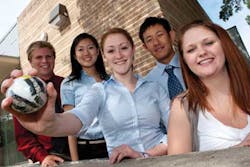Video gets a grip on pitching technique
Students at Rice University (Houston, TX, USA; www.rice.edu) have developed a vision-based tool that can be used for the qualitative analysis of a baseball pitcher's grip.
Although grip is an essential part of pitching technique, current video-based analysis does not provide detailed grip information. Thus a method was required to discover the exact position and force of the pitching hand with respect to the ball during the process.
The so-called Pitch Pressure Analysis and Logging System, or PitchPALS, developed at Rice employs a baseball that contains 28 piezoelectric sensors placed along the seams of the ball.
The sensors record the contact points between the pitcher's hand and the ball, as well as the exact amount of force exerted throughout the entire pitching motion. A voltage divider circuit then turns the force value into voltage signals that are converted into digital data and stored on a MSP340 microprocessor from Texas Instruments (Dallas, TX, USA; www.ti.com), after which they can be transferred to a host computer using a UART through a USB connector.
While the sensors record force and position data during the pitching motion, a A504k CMOS area-scan video camera from Basler Vision Technologies (Ahrensburg, Germany; www.baslerweb.com) interfaced to a PCIe-1433 Camera Link frame grabber from National Instruments (Austin, TX, USA; www.ni.com) simultaneously captures images of the pitcher to a PC. The force data are then presented in a 3-D map as the force sensor data and the video footage are synchronized in a graphical user interface (GUI) developed using National Instruments DIADEM software.
The system was tested by pitchers who threw the PitchPALS baseball into a net from a distance of 40 ft at approximately 50 mph while the camera recorded their full body motion. After each pitch, data were transmitted to a computer through the UART and USB connection. The system recorded significant changes in force on the baseball during the pitching motion.
The researchers hope to integrate wireless communications into the system, and to increase the sample rate of data acquisition, delivering higher-resolution data. They also expect to test and improve the durability of the system so that it can be used at pitching speeds up to 90 mph. They believe that the system could be used to train young pitchers to master an ideal grip of the ball, identify errors in grip technique, and use the data to detect a pitcher's fatigue points.
